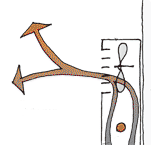Energy
Designing homes to conserve energy and use it efficiently, from sources that cause least environmental harm.
Convection heaters
In convection heating, air is heated when it comes into contact with hot surfaces in the heater. People feel warmer because of the higher air temperature. Some convection heaters use a fan to draw the cool air in.
On this page:
- Types of residential convection heaters
- Characteristics of convection heaters
- Convection heaters with thermal mass.
Types of residential convection heaters
Typical residential electric convection heaters include:
- wall-mounted panel heaters
- wall-mounted or freestanding fan heaters
- oil column or nightstore storage heaters, which incorporate a small amount of thermal mass
- ducted central heating systems with floor or low-wall grilles.
Typical residential gas-fired convection heaters include:
- balanced flue gas heaters
- boiler supplying hot water radiators
- ducted central heating systems with floor or low-wall grilles.
Buying and installing a flued gas heater is likely to cost around the same as buying and installing a heat pump with similar capacity. The economics of operating flued gas convection heaters is best when they burn reticulated (piped) natural gas. Although they can also run with bottled LPG, running costs can be up to twice as high compared to natural gas.

- Convection heater with fan
Cool air is drawn in and passed over gas or electric heating elements. Warm air moves out into the room by natural convection.
Note: BRANZ does not recommend the use of unflued convection gas heaters because they emit water vapour and other gases into indoor spaces.
Characteristics of convection heaters
Convection heaters:
- heat the space from the top down – for larger spaces or spaces with high ceilings, it will take some time for the heat to reach occupant level, particularly when the occupants are sitting
- raise room air temperature more quickly than radiant heaters
- use more energy to achieve the same temperature change as radiant heating in larger spaces
- change the air temperature gradually (fans may increase the rate of air movement), which means that occupants only gradually feel warmer
- make the air warmer close to the heater, so space heating relies on adequate air movement
- create convection currents and temperature gradients as warmer air from the heater rises.
Convection heaters with a fan warm the air faster and provide more even heat in a room.
Convection heaters with thermal mass
Convection heaters may also incorporate thermal mass. Examples include hot water radiators, nightstore or oil column heaters, underfloor heaters and solar hydronic heaters. Heaters with high thermal storage generally don’t get as hot on the surface as heaters with low thermal storage, and therefore have steadier heat output.
High thermal storage heaters can be useful for:
- heating spaces with longer periods of occupancy, for example, beyond about 15 minutes
- heating larger spaces that require more even temperature throughout
- providing low impact heating (lower rates of temperature change and lower air velocity)
- spaces where there is a significant distance to the occupant from the heater
- situations where air temperature needs tighter control over extended periods of time
- rooms where there are high transmission heat losses through walls or the floor or ceiling (for example, a conservatory in winter).
More information
- www.smarterhomes.org.nz – heating
Updated: 25 August 2021

